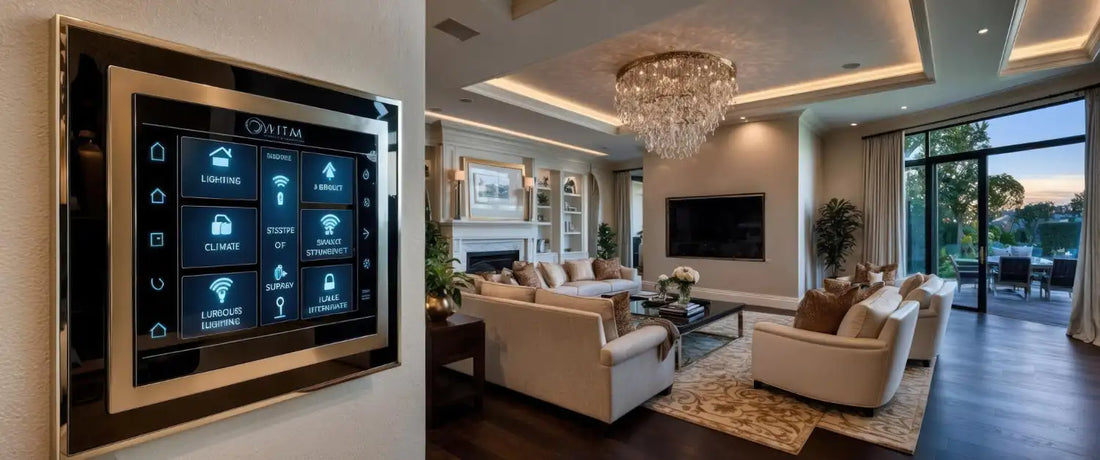
DALI Lighting Control Australia: Energy Savings & Smart Solutions
DALI (Digital Addressable Lighting Interface) is a globally recognised standard for digital lighting control, officially adopted in Australia as AS/NZS 62386 (IEC 62386 parts 101–304). This standard provides a consistent framework where lighting devices – including LED drivers, fixtures, sensors, wall switches, and emergency fittings – can communicate on the same protocol.
In practice, DALI Lighting Control Australia allows products from different manufacturers to work seamlessly together, making it easier for builders, engineers, and facility managers to design and maintain efficient lighting systems.
Unlike traditional on/off switching or simple dimming systems, DALI uses a two-way digital communication method. This means each device can be individually addressed, controlled, and monitored. For example, a facility manager can dim or brighten a single luminaire, create groups of lights for larger spaces, or set up automated “scenes” tailored to specific activities.
Because DALI is bi-directional, it also provides feedback, allowing the system to report faults, monitor lamp performance, and schedule maintenance automatically. This capability reduces downtime and lowers long-term operating costs.
In Australia, the rise of DALI adoption is closely linked to energy efficiency goals and sustainability standards. Businesses and developers are under increasing pressure to reduce energy usage and meet strict environmental targets. DALI lighting systems support these requirements through advanced features such as daylight harvesting, where sensors adjust artificial light levels in response to natural daylight, and occupancy detection, which ensures lights operate only when spaces are in use.
These smart controls directly contribute to reducing electricity consumption and help buildings achieve higher ratings under NABERS and Green Star certification schemes.
The flexibility of DALI lighting control also makes it suitable for a wide range of applications, from small residential projects to large-scale commercial developments. Modern offices, universities, hospitals, and retail outlets across Australia are adopting DALI to improve lighting quality, enhance user comfort, and achieve long-term cost savings.
With the ability to integrate seamlessly with LED lighting – now the dominant technology in Australia – DALI provides a future-proof solution that aligns with both current needs and emerging building automation trends.
In short, DALI Lighting Control Australia represents more than just a technical upgrade. It is a practical, energy-efficient, and future-ready system that is becoming the standard for smart lighting in Australian projects of all sizes.
How DALI Works: The Tech Behind the Magic
Under the hood, DALI systems use a simple two-wire bus alongside the power lines. That’s it – no extra complex wiring. Think of it as a special “chat line” connecting up to 64 devices (lights, ballasts, sensors, exit signs, etc.) on one circuit. Because it’s digital, every device can talk back. Lights report their status; emergency fittings can auto-test themselves. Installers love this two-way communication because if a bulb fails or a wire goes loose, the system throws an alert. This cuts maintenance: no more hunting for a flickering lamp in a hallway – the system tells you exactly which light’s wonky.
On the user side, a DALI controller (sometimes tucked away in a comms cabinet or cloud platform) sends commands to each light. You might have wall panels, smartphone apps or even voice assistants to tell the system what to do. Want a “Movie Night” scene at home? The lights dim and warm up. Heading out on holiday? A schedule can simulate sunrise and sunset.
Because of standards compliance, you aren’t locked into one brand. Mix and match drivers and fixtures – any DALI-certified device plays nicely together. It’s like having Wi-Fi for your lights, and the benefits are huge. In fact, projects from Sydney’s Commonwealth Technology Park to Canberra’s Dickson Interchange showcase DALI’s flexibility: thousands of fixtures, sensors and scenes all managed seamlessly.
Energy Efficiency: Save Power & Money
Here’s the bottom line: DALI lighting system Australia installations are built to cut energy bills. By nature, they enable lean lighting:
-
Daylight Harvesting: Sensors gauge sunlight levels and automatically dim or switch off LEDs when there’s enough natural light. One industry report notes that daylight harvesting (combined with timed schedules) delivers significant energy savings in open-plan offices.
-
Occupancy/Motion Control: Rooms and corridors only light up when needed. In large facilities, DALI networks can support dozens of PIR or infrared sensors per bus, so lights only kick on for people. This per-fixture control slashes waste – if your buddy walks out of the loo and forgets the light on, the system does the turning off for them.
-
Dimming & Zoning: Rather than full power all the time, lights adjust to demand. Lower brightness uses less electricity and extends lamp life. You can create zones (meeting room vs. open cubicles) and tailor brightness separately.
All these features mean instant wins on sustainability ratings. In fact, DALI’s ability to score high NABERS or Green Star credits makes it popular with architects. One smart Aussie facility used DALI to earn top marks by combining 3,200 sensors with 4,400 DALI luminaires – the system even ran emergency lighting tests from the same network. That’s what we call a smart lighting makeover.
Table: DALI vs Other Lighting Controls (simplified)
|
Feature |
DALI |
0-10V Analog |
KNX (Building Bus) |
|
Individual fixture control |
✔ (each light has an address) |
✘ (controls entire circuit) |
✔ (with enough devices) |
|
Bi-directional comm. |
✔ (real-time feedback/status) |
✘ |
✔ |
|
Interoperability (open std) |
✔ (especially DALI-2 devices) |
✘ |
✔ |
|
Requires dedicated cabling |
Yes (dedicated 2-wire bus) |
Yes (control wiring) |
Yes (bus wiring) |
|
Works with LED lighting |
✔ (designed for LEDs and drivers) |
✔ (with LED drivers) |
✔ |
Looking at the facts: unlike old 0-10V dimmers, DALI can talk back and seamlessly mix brands. Compared to KNX (another open standard), DALI is specialized for lighting which often makes it simpler to deploy. In all cases, DALI supports modern LED drivers natively.
Smart Integration & Everyday Comfort
Beyond energy bills, DALI means more comfortable spaces. Picture this: you roll into the office at sunrise, and the lights gradually brighten to match the morning sun’s hue. In a late-night study session, the lights get warmer and less intense to help you wind down. These “circadian lighting” tricks are a breeze with DALI-2 systems. Some setups allow control by mobile app, or even integration with building systems like HVAC or security.
Plus, DALI systems simplify maintenance. Lights self-report failures or end-of-life, so maintenance staff get alerts instead of sifting through fixtures. In a mall or campus, that adds up to saved labor and less downtime. And if you are a facility manager? You can even pull simple analytics: see which floor or tenancy is hogging the most power, or schedule overnight “lights out” profiles automatically.
Whether it’s a sleek hotel lobby or a college classroom, DALI systems shine. They enable “scenes” – preset moods – with a button or app. They adapt to events (e.g. brighter lights when motion sensors pick up activity), and they play nice with emergency lighting. Today’s DALI-2 can test its own emergency backup lights on schedule, keeping you safe and code-compliant. In short, DALI Lighting Australia isn’t just high-tech, it’s highly practical.

DALI in the Australian Market
Why talk about DALI in Australia? For starters, Aussie businesses and builders have embraced it. The Digital Illumination Interface Alliance (DiiA) notes that DALI is extensively used worldwide and was made an Australian Standard. Many local suppliers (like Ektor, Zencontrol, Clipsal’s Dynalite and others) now offer DALI-ready equipment. This ecosystem means you can shop Aussie and global brands and still integrate everything.
Australia’s intense sun and push for energy efficiency make DALI extra appealing here. Architects use it to tick all the green boxes. For example, consider offices or retail spaces: DALI lets them adjust lighting for different zones, saving energy after hours without flipping any switches. Schools and universities use automated dimming to focus students during the day, and hospitals use tunable white to support patient wellbeing – all with the same DALI backbone.
High-profile projects show DALI’s impact: from Commonwealth Park’s sprawling office complex with 11,000+ occupants to Canberra’s Dickson interchange, Australian developments are saving energy and maintenance headaches with DALI-2 systems. Even the emergency services benefit: modern DALI setups can trigger exit signs and alarms if needed, and report their status in real time.
If you’re renovating or building in Sydney, Melbourne, Brisbane or beyond, chances are a DALI lighting system is on the spec sheet. Lighting consultants often advise it for new constructions and retrofits because it future-proofs the installation. Standards Australia is literally buying the manuals to the DALI protocol for resale, so the genie’s out of the bottle – DALI’s here to stay.
Getting Started with DALI
You’re sold on the idea? Great. A basic DALI lighting control setup consists of:
-
DALI-compatible luminaires or drivers (LED panels, troffers, downlights with DALI drivers)
-
One or more DALI controllers (this could be a simple wall switch with DALI output up to a sophisticated app or building management interface)
-
DALI power supply (the two-wire bus still needs a small DC power unit to run)
-
Sensors & switches (motion detectors, light sensors, or wall pads add intelligence).
Installation-wise, electricians just daisy-chain the DALI bus along with regular power cables. Each network line can have up to 64 addresses, and you can add more lines if needed. Programming the system can be done on-site via a PC or even over Ethernet in advanced controllers. Thanks to two-way DALI-2, updates are easy – swap in a new lamp or change the layout without hard rewiring.
Retrofitting is also popular. Want DALI but have old LED fixtures? No problem: you can fit DALI LED drivers or use simple on/off converters to bring legacy lights onto the network. It even works for outdoor lighting; many smart streetlights now have DALI guts inside. With plenty of professional integrators across Australia (try Zencontrol, Philips Dynalite, Schneider Electric, etc.), help is at hand if DIY isn’t your thing.
Conclusion
Modern lighting shouldn’t be dumb. DALI Lighting Control Australia brings a touch of genius to any space. It tailors lighting to real needs, boosts comfort, and – best of all – slashes power bills and maintenance. With official Aussie standards behind it and real-world projects proving the savings, DALI is more than a buzzword: it’s a smart solution for the future.
Whether you’re a building manager or a home automation enthusiast, diving into DALI could be one of the savviest moves you make. Ready to see the light? Talk to a local lighting pro or check out suppliers of DALI-capable LED lighting in Australia. Your electricity meter (and your eyeballs) will thank you!
FAQs
What is DALI lighting control?
DALI (Digital Addressable Lighting Interface) is a smart digital protocol for controlling lights. It lets each fixture be individually dimmed or monitored, often used in modern LED lighting systems.
How does DALI save energy?
DALI systems use features like daylight harvesting, occupancy sensors and dimming to cut waste. Lights only run at needed brightness or switch off, which can significantly reduce power use.
Is DALI compatible with LED lighting?
Yes! DALI is designed with LEDs in mind. Many LED drivers have built-in DALI interfaces. In fact, DALI works seamlessly with various LED fittings, making LED lighting in Australia smarter and more efficient.
Can I integrate DALI with other systems?
Absolutely. DALI controllers often support building management (HVAC, security) and IoT integrations. You can control lights from mobile apps or link them to sensors and other smart home devices for a unified system.
Why is DALI popular in Australia?
Australia formally adopted DALI as its national lighting standard, ensuring broad support. Plus, DALI helps Aussie buildings meet strict energy and safety codes, making it an easy choice for new construction and renovations.
